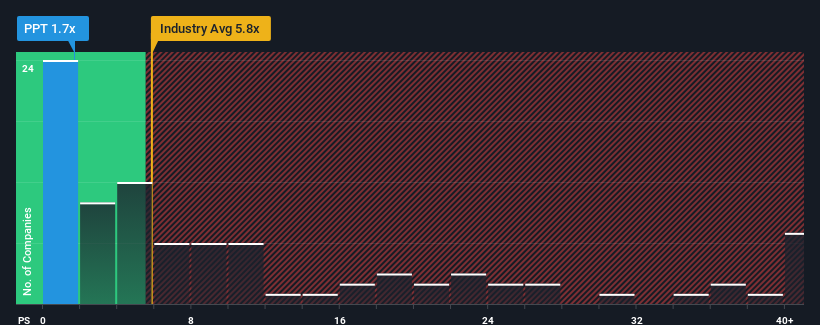- Australia
- /
- Capital Markets
- /
- ASX:PPT
Perpetual Limited's (ASX:PPT) Revenues Are Not Doing Enough For Some Investors
With a price-to-sales (or "P/S") ratio of 1.7x Perpetual Limited (ASX:PPT) may be sending very bullish signals at the moment, given that almost half of all the Capital Markets companies in Australia have P/S ratios greater than 5.8x and even P/S higher than 17x are not unusual. However, the P/S might be quite low for a reason and it requires further investigation to determine if it's justified.
See our latest analysis for Perpetual

How Has Perpetual Performed Recently?
Recent times have been advantageous for Perpetual as its revenues have been rising faster than most other companies. It might be that many expect the strong revenue performance to degrade substantially, which has repressed the share price, and thus the P/S ratio. If the company manages to stay the course, then investors should be rewarded with a share price that matches its revenue figures.
Want the full picture on analyst estimates for the company? Then our free report on Perpetual will help you uncover what's on the horizon.What Are Revenue Growth Metrics Telling Us About The Low P/S?
Perpetual's P/S ratio would be typical for a company that's expected to deliver very poor growth or even falling revenue, and importantly, perform much worse than the industry.
Retrospectively, the last year delivered an exceptional 31% gain to the company's top line. The latest three year period has also seen an excellent 108% overall rise in revenue, aided by its short-term performance. Therefore, it's fair to say the revenue growth recently has been superb for the company.
Turning to the outlook, the next three years should generate growth of 2.3% each year as estimated by the nine analysts watching the company. That's shaping up to be materially lower than the 7.5% per annum growth forecast for the broader industry.
With this in consideration, its clear as to why Perpetual's P/S is falling short industry peers. Apparently many shareholders weren't comfortable holding on while the company is potentially eyeing a less prosperous future.
What Does Perpetual's P/S Mean For Investors?
Typically, we'd caution against reading too much into price-to-sales ratios when settling on investment decisions, though it can reveal plenty about what other market participants think about the company.
As we suspected, our examination of Perpetual's analyst forecasts revealed that its inferior revenue outlook is contributing to its low P/S. Right now shareholders are accepting the low P/S as they concede future revenue probably won't provide any pleasant surprises. It's hard to see the share price rising strongly in the near future under these circumstances.
And what about other risks? Every company has them, and we've spotted 1 warning sign for Perpetual you should know about.
If companies with solid past earnings growth is up your alley, you may wish to see this free collection of other companies with strong earnings growth and low P/E ratios.
New: Manage All Your Stock Portfolios in One Place
We've created the ultimate portfolio companion for stock investors, and it's free.
• Connect an unlimited number of Portfolios and see your total in one currency
• Be alerted to new Warning Signs or Risks via email or mobile
• Track the Fair Value of your stocks
Have feedback on this article? Concerned about the content? Get in touch with us directly. Alternatively, email editorial-team (at) simplywallst.com.
This article by Simply Wall St is general in nature. We provide commentary based on historical data and analyst forecasts only using an unbiased methodology and our articles are not intended to be financial advice. It does not constitute a recommendation to buy or sell any stock, and does not take account of your objectives, or your financial situation. We aim to bring you long-term focused analysis driven by fundamental data. Note that our analysis may not factor in the latest price-sensitive company announcements or qualitative material. Simply Wall St has no position in any stocks mentioned.
About ASX:PPT
Undervalued with moderate growth potential.
Similar Companies
Market Insights
Community Narratives



